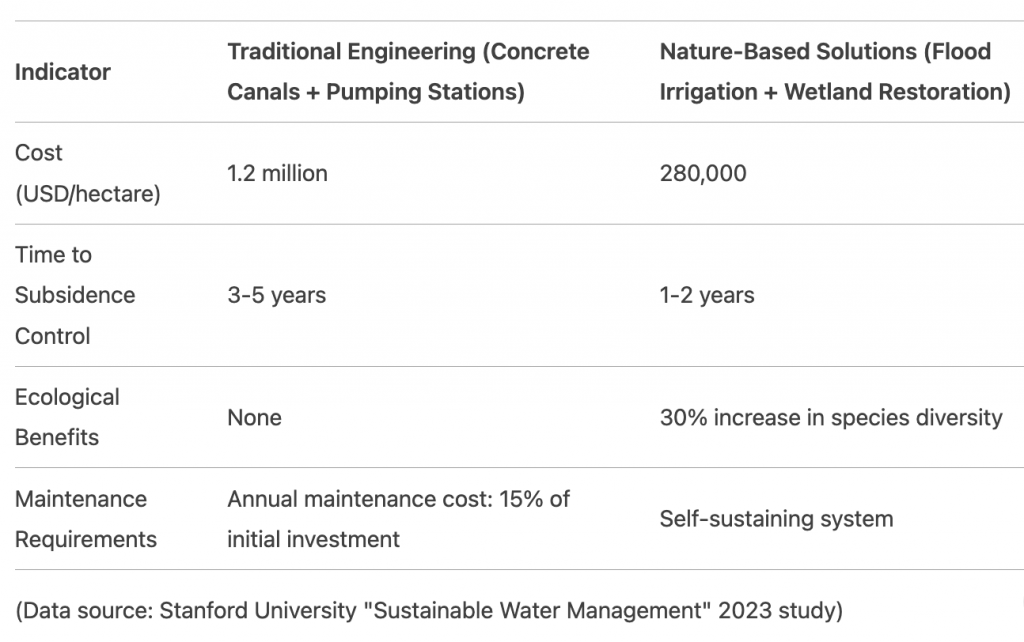【能源与环境】 | Energy & Environment
By Yibai, Jointing.Media, in Shanghai, 2025-02-15

According to 2023 satellite monitoring data jointly released by NASA and NOAA, parts of California’s Central Valley have experienced land subsidence at a rate of 30 centimeters per year due to prolonged groundwater over-extraction, with some areas sinking over 3 meters cumulatively in the past decade. This phenomenon directly correlates with California’s cyclical droughts and surging agricultural water demand, having already caused infrastructure damage and increased flood risks.
California’s subsidence is not an isolated case, but rather a microcosm of global geological system imbalances. When humans alter nature at industrial speeds, land subsidence has transformed from a “natural evolution” into a “man-made disaster.” Behind this phenomenon lies the compounded effects of resource exploitation, short-sighted planning, and climate change.
Invisible “Black Holes” Devouring Our Cities
Home to over 10 million people, Indonesia’s megacity is subsiding at 25 cm annually—with its northern districts projected to vanish beneath the sea by 2050. Rampant groundwater extraction and the crushing weight of skyscrapers are overwhelming its alluvial foundations.
The ancient decision to build on a drained lake now haunts modern Mexico. The city center has dropped 12 meters in a century, crippling drainage systems and turning rainy seasons into urban floods.
The Adriatic’s romantic jewel has sunk 23 cm in the 20th century from rising seas and subsidence. Its €5.5 billion “MOSE Project” floodgates offer only temporary respite.
Across the Yangtze River Delta and North China Plain, 50+ cities report land subsidence. In Shanghai’s Lujiazui financial district, skyscrapers compress the earth, while Tianjin’s petrochemical zone pumps away its underground support.
UNESCO confirms human-induced subsidence now affects 150 nations—a silent crisis rewriting the world’s coastlines.
Satellites Can Monitor Subsidence, But Not Mend Systemic Fractures. NASA’s InSAR (Synthetic Aperture Radar) technology can detect ground movements as subtle as millimeters, while the Netherlands has pioneered the world’s first real-time subsidence early-warning system using satellite data. Yet these technological feats reveal a deeper paradox: the more humanity relies on cutting-edge tools to “monitor” nature, the more it exposes its departure from sustainable development principles.
In California, farmers relentlessly drain aquifers to sustain almond crops (each nut requiring 4 liters of water). Jakarta’s affluent districts flout municipal bans, drilling illegal deep wells for clean water. Oil-rich Middle Eastern nations pump groundwater to maintain emerald golf courses… When “development rights” and “survival rights” are reduced to resource warfare, technological monitoring ironically becomes a “certificate of impunity” for exploitation.
Land subsidence and climate change form a vicious cycle—droughts force increased groundwater extraction, while subsidence damages water infrastructure, exacerbating waste. Rising seas invade sinking coastlines, demanding energy-intensive levees. This “combat-against-nature” mindset peaks in projects like Venice’s canal diversions and Tokyo’s Metropolitan Area Outer Underground Discharge Channel, yet traps societies in a paradox: the grander the engineering, the more fragile the system.
At its core, the subsidence crisis reflects civilizational unsustainability. Contrast this with the Netherlands’ “Room for the River” program post-1953 floods, where dikes were dismantled to restore floodplains, replacing rigid resistance with adaptive resilience. Or Bangkok’s 300% groundwater tax hike, spurring corporate rainwater harvesting. These prove subsidence isn’t a technical glitch, but a value-system failure.
The IPCC’s 2023 report notes nature-based solutions could address 35-40% of global subsidence—if paired with pumping regulations and land-use controls. Humanity must learn to design progress within planetary thresholds.
Four Natural Pathways to Reverse Land Subsidence
At its core, land subsidence signals a destabilized geological system—yet humans are now recruiting nature’s allies to restore balance. From wetland regeneration to microbial soil stabilization, from aquifer recharge to saltmarsh barriers, a quiet revolution is leveraging ecological wisdom to counter ground collapse. These pilot projects not only prove nature’s capacity for repair but also challenge the engineering-first governance dogma.
1. Aquifer Recharge
Diverting stormwater and recycled water to replenish overexploited aquifers restores pore pressure and slows strata compression. Examples:
- California’s Central Valley: Launched in 2014, its groundwater recharge program floods fallow farmland during winter, replenishing 320 million m³ annually. Some areas saw 40% slower subsidence.
- Jakarta, Indonesia: Built 200 infiltration ponds in its sinking north (25→18 cm/year after 2021-2023), paired with pumping restrictions.
2. Wetland & Vegetation Anchoring
Root systems weave subsurface rebar nets—stabilizing soils while transpiration reduces water extraction needs. Case studies:
- Tianjin, China: Planting tamarisk-reed wetlands around petrochemical zones boosted soil bearing capacity by 15%, cutting subsidence 22% over 5 years.
- Mexico City: Restored Chinampas floating farms in Xochimilco, using aquatic plant roots to bind lakebed sediments. Subsidence plummeted from 40 cm/year (1990s) to 5 cm/year (2020).
3. Microbial Mineral
Injecting urea-degrading bacteria triggers calcite precipitation, cementing loose sediments. Delft University’s MICP trial at Rotterdam Port increased sand layer strength by 300% in 6 months—at 1/3 the cost of grouting.
4. Coastal Saltmarshes
Tidal plants like Spartina build land while buffering sea rise-subsidence synergy. San Francisco Bay’s 1,600-hectare saltmarsh restoration (paired with oyster reefs) reduced nearby land subsidence by 1.5 cm/year (NOAA 2022).
Nature-based solutions have revolutionized the efficiency and cost-effectiveness of traditional engineering approaches. Take California’s San Joaquin Valley as an example:
However, nature-based restoration approaches also face limitations and challenges. In densely urbanized areas, land scarcity makes wetland construction difficult—Jakarta has experimented with “vertical infiltration wells” to compensate for space constraints. Arid regions lack sufficient water for aquifer recharge, prompting Saudi Arabia to trial “atmospheric water harvesting + nanomembrane filtration” to produce infiltration water. Policy inertia remains another hurdle, as seen in Mexico City’s continued reliance on a $1.3 billion concrete drainage tunnel rather than fully transitioning to ecological restoration.
The governance of land subsidence is undergoing a paradigm shift—from “combating nature” to “negotiating with nature.” The Netherlands’ “Sand Engine” project exemplifies this: by depositing 21 million cubic meters of sand offshore and letting ocean currents naturally distribute it into protective barriers, the country saved 70% of traditional coastal reinforcement costs. Similarly, China’s Xiongan New Area employs “underground reservoirs,” using natural depressions to store stormwater while replenishing aquifers and creating urban sponge spaces, achieving a projected 90% subsidence control rate.
The geological clock cannot be rewound. Land subsidence serves as a mirror, reflecting industrial civilization’s “bulldozer-style exploitation” of Earth. As cities sink into the red zones of predictive models, the true solution lies not in more advanced monitoring or sturdier levees, but in rediscovering reverence for geological time—humanity must learn to plan development within ecosystems’ carrying capacity, or risk civilization sinking into the abyss of its own making.
When subsidence is reframed from a “technical problem” to a “civilizational model problem,” nature-based restoration’s value transcends ground elevation—it forces humanity to renegotiate its contract with Earth. Only by relinquishing the arrogance of “dominion over nature” can we discover the wisdom to coexist with geological time.
References:
- https://www.jpl.nasa.gov/news/central-california-sinking-at-alarming-rates-nasa-uci-study-finds)
- https://ca.water.usgs.gov/projects/central-valley/land-subsidence-monitoring.html
- https://oceanservice.noaa.gov/hazards/sealevelrise/sealevelrise-tech-report.html
- https://water.ca.gov/News/News-Releases/2023/June/DWR-Releases-Updated-Land-Subsidence-Data
- https://water.ca.gov/Programs/Groundwater-Management/SGMA-Groundwater-Recharge
- https://www.ecologica.cn/jzy/index.aspx
- https://idp.nature.com/transit?redirect_uri=https%3A%2F%2Fwww.nature.com%2Farticles%2Fs41587-023-01769-w&code=df2f2add-0165-4847-8a30-f09102fa2fc8
- https://coast.noaa.gov/data/digitalcoast/pdf/sfbay-restoration.pdf
- https://www.zandmotor.nl/en/
- https://www.ipcc.ch/report/ar6/syr/
- https://water.ca.gov/Programs/Groundwater-Management/SGMA-Groundwater-Recharge
- https://pupr.jakarta.go.id
- https://www.ecologica.cn/jzy/index.aspx
- https://idp.nature.com/transit?redirect_uri=https%3A%2F%2Fwww.nature.com%2Farticles%2Fs41587-023-01769-w&code=df2f2add-0165-4847-8a30-f09102fa2fc8
- https://coast.noaa.gov/data/digitalcoast/pdf/sfbay-restoration.pdf
- https://www.zandmotor.nl/en/
Text Editor: Jas
Image Editor: SQM
Ralated:


![[Recruiting 2011] Jointing.Media](http://jointings.org/eng/wp-content/themes/news-magazine-theme-640/cropper.php?src=/cn/wp-content/uploads/2012/06/123.png&h=50&w=50&zc=1&q=95)









